Five weeks ago the London-based newspaper Financial Times broke a story that Wells Fargo, one of the largest banks in the world, had issued a memo banning their staff from taking part in Lending Club and Prosper (full article). The key line of the Wells Fargo memo is:
“… peer-to-peer lending is a competitive activity that poses a conflict of interest.”
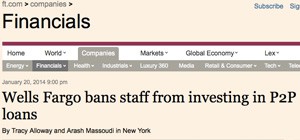 Financial Times then went on to analyze why this ban was issued, stating that “tensions between banks and peer-to-peer platforms have arisen because the P2P model cuts traditional lenders out by matching capital directly with borrowers [emphasis mine].” So in the view of Financial Times, the decision of Wells Forgo to forbid their employees from entering the peer to peer space had to do with how Lending Club and Prosper directly threaten Wells Fargo as a company.
Financial Times then went on to analyze why this ban was issued, stating that “tensions between banks and peer-to-peer platforms have arisen because the P2P model cuts traditional lenders out by matching capital directly with borrowers [emphasis mine].” So in the view of Financial Times, the decision of Wells Forgo to forbid their employees from entering the peer to peer space had to do with how Lending Club and Prosper directly threaten Wells Fargo as a company.
Kathleen Pender at the San Francisco Gate then approached Wells Fargo for further comment two days later (full article). Wells Fargo replied to Pender’s piece with a wordy paragraph containing this key statement:
“In response to a specific question about investments in peer to peer lending companies from a small group of team members in one of our licensed businesses […] the guidance given to these team members was based on our code of ethics.”
In short, Wells Fargo disagreed with the Financial Times’ angle that the memorandum was issued for competitive reasons, instead arguing that the memo was issued for purely ethical considerations.
Financial experts did not buy it. Mark Calvey of the San Francisco Business Times transitioned from news of the memo into highlighting how “the lending platforms can offer loans at lower rates than banks charge.” CNBC moved from the memo to immediately talking about how peer to peer lending is “cutting out the bank“. David Snitkof at Orchard Platform analyzed both the ethical and competitive angles – himself leaning into the memo’s rationale being about the threat that peer to peer lending poses to Wells Fargo’s future:
“Wells Fargo’s new policy may be an example of how a new incumbent reacts to a potentially disruptive new business model.”
(Wells Fargo Restricts Employees From P2P Lending)
In summary, the jury has returned with a verdict: Wells Fargo feels threatened by peer to peer lending. This, then, poses the question that we will attempt to answer today: how does a company like Lending Club or Prosper pose a threat to one of the largest banks in the world?
Wells Fargo versus Peer to Peer Lending: Size Comparison
A cursory comparison of the two institutions reveals stark differences. For instance, let’s look at the income of Wells Fargo as compared to Lending Club (last reported quarter):
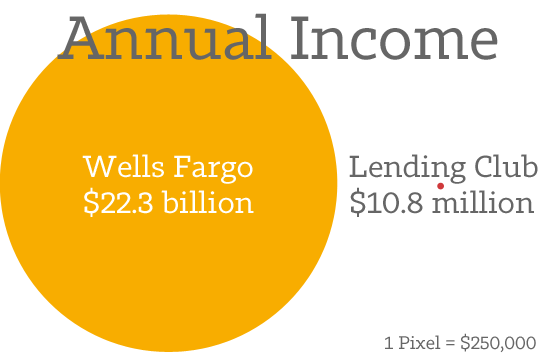
Or consider the number of employees at Wells Fargo’s disposal:
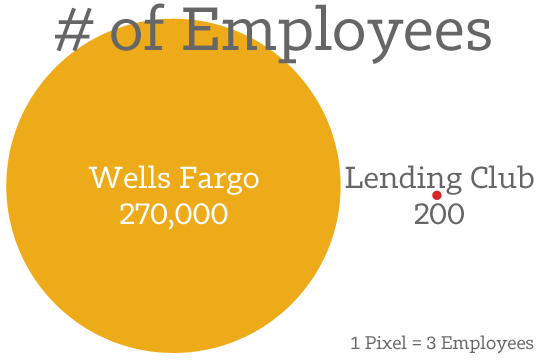
In short, when looking at size alone, Wells Fargo should not have any reason at all to worry about this “fringe” sector (MarketWatch). And yet they issued a corporate embargo against a company a fraction of their size. Comparing GDP, this is akin to the United States of America issuing a trade embargo against the island nation of Mauritius.
So something else must be going on, and I think it has something to do with how this new way of issuing loans “cuts traditional lenders out” (as stated by the Financial Times piece). The technical term for being cut out like this is disintermediation, and its power becomes easier to understand if we take a small detour down digital-memory lane.
How the MP3 File Killed the Music Industry
 Let’s remember back to the bygone internet days of June 1999. A fuse had just been lit that would go on to have an astounding global impact. A music distribution program called Napster was quietly released, taking advantage of a new compression technology called MP3, a file format that dramatically shrank the space used by a digital song file. Whereas before digital music took up too much space to be transferred via the modems we used back then, suddenly everyone’s favorite music was available with the click of a mouse. The nation began (illegally) downloading their favorite songs with carefree abandon. Napster reached an astounding 10 million unique users in less than two years time.
Let’s remember back to the bygone internet days of June 1999. A fuse had just been lit that would go on to have an astounding global impact. A music distribution program called Napster was quietly released, taking advantage of a new compression technology called MP3, a file format that dramatically shrank the space used by a digital song file. Whereas before digital music took up too much space to be transferred via the modems we used back then, suddenly everyone’s favorite music was available with the click of a mouse. The nation began (illegally) downloading their favorite songs with carefree abandon. Napster reached an astounding 10 million unique users in less than two years time.
What happened next is the stuff of history. The record industry fought tooth and nail against digital music, a national superpower versus a five megabyte file. Lawsuits were issued. Napster’s creator Shawn Parker was sued and forced to shut down. Terse FBI warnings were emblazoned on a billion audio CDs, and famous rock bands like Metallica joined the cause against piracy. The record companies, previously stiff competitors, suddenly made nice and threw the entire collaborative weight of their industrial bulwark against this problem, desperate to remain in power.
The 5MB file won. Back in 1999, the music industry was experiencing record revenues, around $19 billion. By 2009, just ten years later, it was 40% of its size (source).
These days the record companies have been relegated to a humbler corner of the overall music ecosystem, making the majority of their profit from the sales of digital singles. They still promote artists and produce music, but their power has been greatly diminished.
Furthermore, this digitization of the global economy has been happening everywhere, and it has been slaying all sorts of industry giants. Kodak, a hundred year old company that was at one point included with other national standards on the DOW Jones index, went bankrupt in 2012 after years of failing to adjust to digital photography. Disintermediation (Wikipedia): it is what happens whenever a product or service makes an established industry player unnecessary and redundant.
How is technology so powerful? It does things cheaply and efficiently.
The key reason of why the MP3 got so popular had to do with one particular feature: its inherent efficiency. Yes, the format allowed many new listening improvements (anyone remember MilkDrop?). But most importantly, the MP3 was simple. Try as they might, the record companies and their immense distribution truck-lines could not complete with the ease of their product being available in people’s homes with the click of a button. The MP3 was just too efficient, too easily gotten, stored, and shared to lose.
The Efficiency of Peer to Peer Lending
 Similarly, Lending Club offers astoundingly low loan rates because they are cheaper and more efficient than banks have ever been. Like iTunes, a peer to peer lending platform is based totally online. They have no vaults or cash-holding requirements. They have no tellers they pay to sit at a counter and await walk-in customers. Lending Club’s only infrastructure is a server farm in Nevada and an office in San Francisco, and this lean profile has allowed a small staff of only 200 employees to issue billions and billions of dollars in loans.
Similarly, Lending Club offers astoundingly low loan rates because they are cheaper and more efficient than banks have ever been. Like iTunes, a peer to peer lending platform is based totally online. They have no vaults or cash-holding requirements. They have no tellers they pay to sit at a counter and await walk-in customers. Lending Club’s only infrastructure is a server farm in Nevada and an office in San Francisco, and this lean profile has allowed a small staff of only 200 employees to issue billions and billions of dollars in loans.
So it makes sense to say that peer to peer lending is to the banks like the MP3 was to the record companies. Both seem starkly simpler mechanisms than the brick and mortar establishments. But can we back up this bold claim with hard data? How can we prove that peer to peer lending out-prices the banking establishment?
To answer this question, the memo-issuing Wells Fargo is actually a perfect comparison. Unlike other big banks in the United States, they regularly issue personal loans through their Community Banking program, loans similar to those of Lending Club.
Operating Expense Ratios: Wells Fargo vs. Lending Club
To make this comparison, we need to compare each company’s efficiency, not their size, but the relative ease with which each company can issue loans at all. For example, if it costs Wells Fargo $2.00 to issue a $1000 loan, and it costs Lending Club $1.00 to issue the same loan, then Lending Club would be twice as efficient.
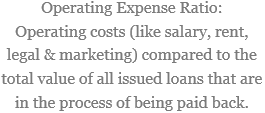 The measure of a loan issuer’s efficiency (their operating expense ratio) is found by dividing (A) a loan issuer’s expenses by (B) the total value of all its loans that are still in the process of being paid back.
The measure of a loan issuer’s efficiency (their operating expense ratio) is found by dividing (A) a loan issuer’s expenses by (B) the total value of all its loans that are still in the process of being paid back.
Finding the Efficiency of Wells Fargo
Wells Fargo makes it easy to discover this ratio through their Investor Relations page. In the Quarterly Supplement for their most recent quarter we find a page titled Community Banking. Underneath are the “Annual Loans, net” and “Noninterest Expense” numbers we can use to calculate the efficiency of Wells Fargo.
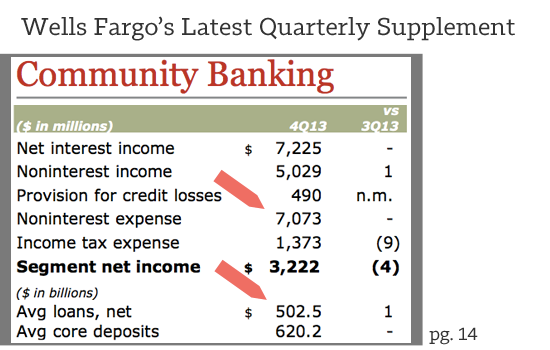
Finding the Efficiency of Lending Club
Lending Club’s operating expense ratio is more complicated to calculate because the company is growing so quickly. We have to open up their most recent 10-Q filing with the Securities & Exchange Commission, find their cost and issued loans for that quarter, and use some math to extrapolate these numbers into perpetuity. Basically, we see how Lending Club did last quarter and project its future as if the company simply repeated last quarter’s performance over and over.
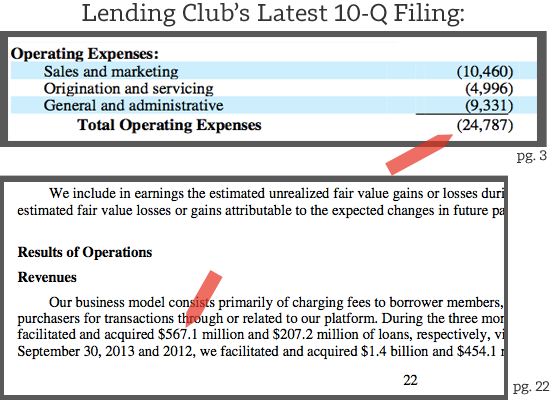
Note: Here is a white paper outlining how I discovered these expense ratios: Why Peer to Peer Lending Will Replace American Banking (pdf).
The chart below contrasts their operating expense ratios, with Lending Club’s projected using their last filed quarter’s performance.
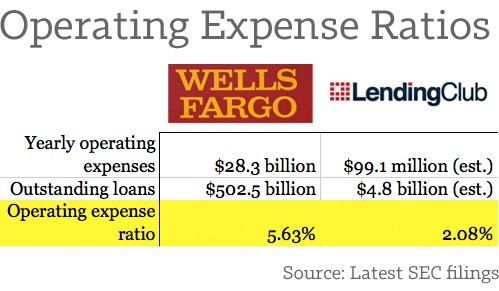
Dividing their expenses by their outstanding loans, we can see that Lending Club is currently something like 270% more efficient as a company than Wells Fargo. The numbers get even more interesting if we zoom the camera out. Here is the efficiency of both companies for the past three years:
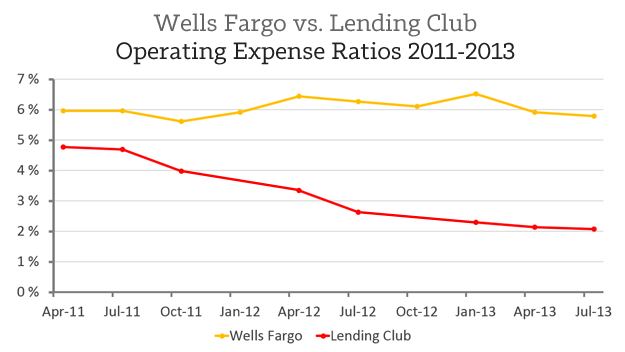
Not only is Lending Club a much more efficient company than Wells Fargo, but their efficiency continues to improve each quarter. In contrast, Wells Fargo’s efficiency generally stays the same, drifting between 5.5% and 6.5%. If you couple this efficiency with Lending Club’s growth chart, a dramatic picture begins to emerge:
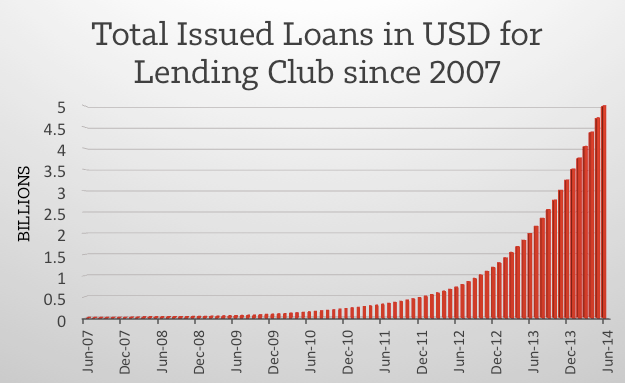
What momentum. It’s possible that peer to peer lending poses the greatest existential threat that American banking institutions have ever faced since their companies began.
Suddenly, Wells Fargo’s memo seems less like an overreaction and more like an understatement. Even though Lending Club is a fraction of the banking titan’s size, its efficiency and growth endangers the very core of Wells Fargo’s business.
How Wells Fargo Will Fight (and Why They Will Lose)
This begs another question: why does a resource-rich company like Wells Fargo feel threatened by peer to peer lending’s efficiency when they could simply create a low-cost platform themselves? Their recent memo shows that they see the writing on the wall, so why don’t they simply pivot their company to match this threat?
I had a chance to sit down with Lending Club’s CEO Renaud Laplanche back in October and ask him this very question. His response:
If you look at the history of innovation, there are very few examples of that happening, of incumbents reducing their cost structure and out innovating the low-cost technology-based entrant. [ … ]
There have been many examples of this happening before, whether it was when Borders could not react fast enough to Amazon or when Blockbuster could not react fast enough to Netflix and eventually went bankrupt. There have also been many attempts at companies trying to survive by spinning out low-cost operations. Ten years ago, because of pressure from Southwest and Jet Blue, all the major airlines spun out low-cost alternatives. Delta launched Song; United launched Ted. But these alternatives ended up having exactly the same cost structure.
Full Interview: Renaud Laplanche on How JP Morgan Chase is Like Blockbuster Video
The Humbling of America’s Banking Industry
Download the white paper: Why Peer to Peer Lending Will Replace American Banking (pdf)
In conclusion, Wells Fargo will never be able to compete with Lending Club because doing so would require too radical of a shift. As Wells Fargo states in their Today brochure, they operate through “more than 9,000 locations”. Each of these nine thousand branches has to be maintained and kept secure, driving up the cost of the company and disallowing them from ever offering lower rates than a peer to peer lending company. Do you think Wells Fargo would be willing to lay-off their 270,000 employees and close thousands of branches if it meant they could survive? Heck no. More likely they will try their best to balance both, and do both poorly.
Interestingly, it seems like the very branches that enable Wells Fargo’s current success are the one thing that will drive them to bankruptcy. I would not be surprised that in twenty years Wells Fargo will be relegated to some niche product like fire insurance, similar to how Kodak, having been ejected from its beloved film industry, spent its final years selling computer printers.
I continue to be transfixed by this dramatic national shift. The greatest economic force in our nation today, arguably in world history, is en route to be humbled by a couple hundred people and a server farm.
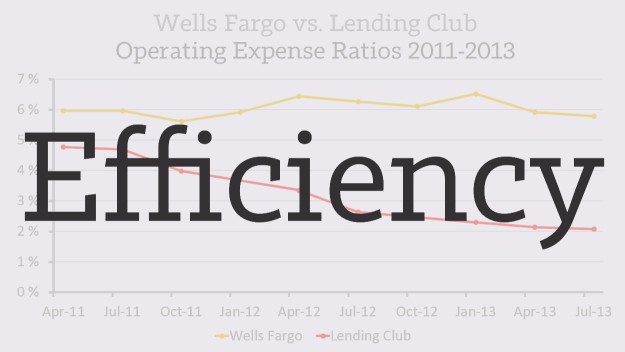
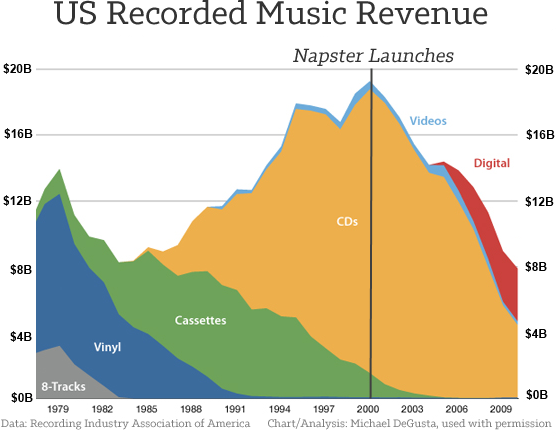
Tremendous article and great analysis Simon. I think you’ve hit the nail on the head with the transformative nature of technology and the consumer lending industry. At the end of the day it comes down to convenience and cost for the consumer. Do I need to leave my home? No. Are the fees/interest rates less? Yes. Since Lending Club can capture this business in a much leaner way, it will purely become a survival of the fittest. Although this industry transformation will not be overnight. The next five-seven years are going to be exciting.
As an aside, much less comparative is small business lending as they are greatly underserved at the moment. Certainly a ripe opportunity for the P2P lending operators to continue their expansion.
Thanks for the comment Adam. Interesting point about small business lending. I’m curious if this has been underserviced considering it is so dependent on risk-based pricing, which has only recently become a practice of loan issuers.
Here’s to the coming thrill of the next 5-7 years.
Great article. Perhaps Wells Fargo executives took notice when Lending Club’s CEO, Renaud Laplanche compared JP Morgan to Blockbuster last Fall. Banks should not be threatened though as they are mostly not interested in this segment of the market – they prefer $1Mil+ small business loans.
Thanks for your comment Don. However, I disagree that banks are not interested in this segment. Wells Fargo and Discover earn a major portion of their revenues through personal loans.
Secondly, this post is not really about a “segment”. It’s about a mode of doing finance that currently serves personal loans, and will slowly spill into all other arenas.
This is powerful data. I think that the same can be said of all online lenders, not just P2P lenders. It is how CashNetUSA disrupted the payday loan industry, OnDeck disrupted the business lending, etc. The internet is both a low-cost money distribution system and a real-time underwriting engine that will dis-intermediate the monopoly of bank lending.
Great article. I at least give Wells Fargo credit for seeing this P2P as a legitimate threat, though they will most likely not react in an innovative way.
What are your thoughts on the possibility of a large banking institution (Wells Fargo or some other group) buying up LC and/or Prosper and effectively shutting it down blatantly or on the sly?
Thoughts on this anyone?
It is unlikely that this would happen. For one, the companies have such a tremendous financial opportunity that I don’t really see money as being as powerful an incentive as it typically is. Secondly, they are so wildly priced that the moment (LC is currently $2.6billion?) that buying them out would be a truly tremendous purchase. Finally, I am not sure buying one company out would stem the rise of another sometime in the future.
That said, it does remain a possibility. The banking institution of this country is a shockingly powerful thing to fight, and I would not be surprised if something like this comes along. Banks like Wells Fargo simply have too much to lose to sit idly by.
This is an entire blog post on its own, but you can see how companies like Lending Club have done a great job at working with national regulators and influencers. They have curried a lot of relational capital with powerful people. Lawrence Summers, who sits on LC’s board, was a previous Secretary of the Treasury in the Clinton Admin. The window for a sneaky backstab power play seems to have passed, but I would not put it past them.
Simon,
I read your article with great interest. I found the Efficiency calculations very interesting – it was the first time I saw a comparison between p2p lenders and traditional lenders with that angle. I think that we are not exactly comparing like for like though – since for banks you would need to factor in the credit risk, whereas for p2p the credit risk is passed on the investors. I have written a post that shows the agent vs. principal issue. Do you agree ?
Hi Huy,
The risks are definitely different, but I don’t think risk directly affects the calculation of efficiency.
Simon
My view is that it would be different because a bank would need to charge the default risk which would worsen its efficiency cost. That’s the reason why Wells Fargo would have to hold capital whereas Lending Club wouldn’t.
Forgot the link of the post last time :
http://www.disruptivefinance.co.uk/?p=1
Right on the money–but remember that, with this dramatic increase in efficiency comes a dramatic decrease in jobs. You can hate banks, brokers and record companies (who doesn’t) but they employ, or in Kodak’s case, employed, lots of people. I’ve been lucky, but I’ve seen enough obsolete individuals to realize “disintermediation” is a very mixed blessing. Be careful what you wish for.
Hi Randy,
Indeed, the blessing is mixed. Lending Club and Prosper hire an amazingly small team to do what they’re doing. However, I would also say that while the internet is sinking more and more “big ships”, its also opening the door to more and more smaller ships to launch. There has never been an easier time in our nation’s history to start a small business than today. IE: this website’s total operating expenses for its first six months (Jan-June 2013) was around $70.
Simon
Great article and comparison, but you are forgetting about the numerous services and revenue streams all banks, especially wells fargo has… business insurance, corporate lending, lending to other banks, international exchange. I am sure they do see a threat to personal loans, but comparing them to blockbuster is a little of a stretch. After this article was written I believe wells reversed its policy on p2p lending.
Services and revenue streams that can be disintermediated by low-cost internet startups? :)
I wonder if the big banks will work to collude with regulators & politicians to heap regulatory requirements on P2P lenders….making them less efficient.
Regulatory burdens to decrease advantage is certainly something for us to watch out for.
Hi
Firstly a well thought article on how leveraging a business with technology will evnetually lead to operational scales and efficiency. However, I must disagree on the comparable used to justify the superiority of LC vis-a-vis Wells Fargo. LC primarily derives its revenue from Fee through processing and technically does not reap benefits of an increased NIM on account of lower cost of funds. On the other hand, a commercial bank deploys its sources through brick and mortar branches that eventually help in raising cheaper liability sources thereby decreasing its aggregate cost of funds. Also, the underwritting for LC is fairly simple and can be automated thereby reducing costs to a further extent while the same cannot be applied to structured obligations or large ticket transactions. Secondly, the average loans outstanding does not truly represent the nature of a commercial bank a large part of it is also attributable to revolving credit/ repaid debt/ non fund transactions including derivatives which also entail operating expenses and are represented in the non interest income. However, i must agree that the existing banks do face a serious threat from technology platforms providing the same services with a soundproof underwritting and regulatory checks in the manner once they can tackle the issue of liquidity and a strong secondary market, they can replace the need for a savings account
Thanks for your excellent comment Maheshwar. Certainly food for thought.
Very interesting post and I was surprised to see such a large difference in operating efficiency of Wells Fargo and Lending Club. However, I think more fairer comparison will be with digital banks like Ally Financial or Capital One 360 (erstwhile ING Direct). None of these have physical presence and hence have lower cost structure. Does Lending club have any advantage over Ally Financial? Also, digital banks have been around for several years and their loan and deposit growth has stalled in last few years. If digital bank could not replace traditional bank even after lower cost structure, why do you think P2P platforms will be able to do so?
Great summary. Got me thinking about where thing are headed: When will Lending Club’s annual total issued loans in USD surpass that of Wells Fargo? How much growth existing growth and bank-cannibalization is left before Lending Club needs to find new markets in order to continue growing?
Wow, just wanted to say awesome article. Been bouncing around your site for a couple hours and it’s been so informative. Thanks for all the work you put into it!
Glad you liked it. Thanks for reading.
Love the article. I was wondering if you had any interest in updating the financials for the Wells Fargo vs. LendingClub comparison for 2016? LendingClub now has nearly 1000 employees so it would be interesting to see if their increased size has affected your efficiency comparison at all. This could potentially say a lot about LC\’s recent stock performance.